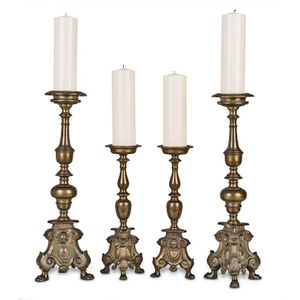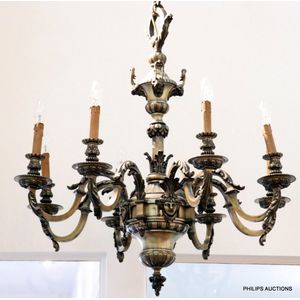Ornate Mazarin-style Bronze Chandelier, 1890
A large Mazarin style eight branch bronze chandelier, circa 1890, finely cast with an ornate stem to a shaped incense style dish issuing square, section 'S' scroll arms supporting bold dishes and sconces with electric, candles, embellished with acanthus leaves, mascarons and formal Baroque, ornaments, height 116 cm, width 96 cm
You must be a subscriber, and be logged in to view price and dealer details.
Subscribe Now to view actual auction price for this item
When you subscribe, you have the option of setting the currency in which to display prices to $Au, $US, $NZ or Stg.
This item has been sold, and the description, image and price are for reference purposes only.
- Sconce - A light attached to a wall. Originally a candle holder that is attached to a wall with an ornamental bracket and sometimes with a reflective back plate, but now applied to an electric light that has been inspired by that design.
In recent times the word has also come into use to desribe the candle holders on a candelabra. - Bronze - An alloy of copper and tin, traditionally in the proportions of about 9 parts of copper to 1 part of tin.
The discovery of bronze in Western Asia in the 4th century enabled people to create metal objects which were superior to those previoulsy possible because of its strength and hardness, and it has been used throughout the world for weapons, coins, tools, statuary and other decorative items.
It is very fluid in a molten state, and its hardness, strength when set, and non-corrosive properties makes it most suitable for casting sculpture. - Circa - A Latin term meaning 'about', often used in the antique trade to give an approximate date for the piece, usually considered to be five years on either side of the circa year. Thus, circa 1900 means the piece was made about 1900, probably between 1895 and 1905. The expression is sometimes abbreviated to c.1900.
- Acanthus - A stylized leaf motif, one of the primary decorative elements of classical Greek and Roman architecture, derived from the genus of flowering plants in the family Acanthaceae, native to tropical and subtropical regions of the Mediterranean area. It is a common element in classical Greek and Roman design, and is often seen in Corinthian and Composite order columns and used as a decorative element in English, European and Australian furniture, particularly on the curve of a leg, and as decoration for a corbel.
This item has been included into following indexes:
Visually similar items

Two pairs of continental bronze pricket candlesticks, 19th century, 54 cm high and 40 cm high
Sold by
in
for
You can display prices in $Au, $US, $NZ or Stg.

A pair of Antique Sheffield plate two branch, three light candelabra, circa 1810, each with leaf and scroll decoration, 50 cm high
Sold by
in
for
You can display prices in $Au, $US, $NZ or Stg.

A large and impressive pair of Victorian silver plate nine-light candelabra, 94 cm high, 60 cm diameter
Sold by
in
for
You can display prices in $Au, $US, $NZ or Stg.

A pair of Sheffield plated candelabra, 19th century. 48 cm
Sold by
in
for
You can display prices in $Au, $US, $NZ or Stg.
